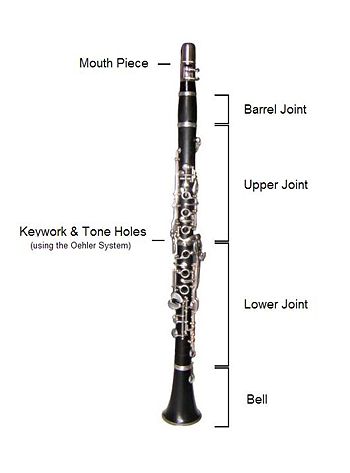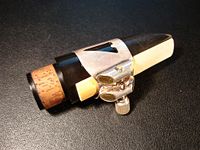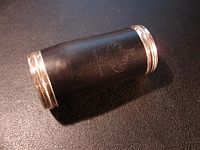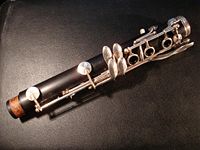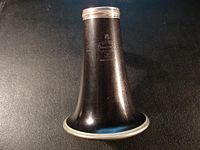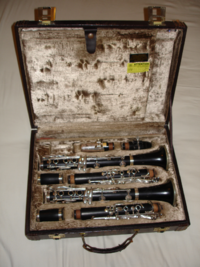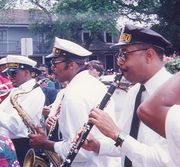Clarinet
2008/9 Schools Wikipedia Selection. Related subjects: Musical Instruments
|
The clarinet is a musical instrument in the woodwind family. The name derives from adding the suffix -et meaning little to the Italian word clarino meaning a particular type of trumpet, as the first clarinets had a strident tone similar to that of a trumpet. The instrument has an approximately cylindrical bore, and uses a single reed.
Clarinets actually comprise a family of instruments of differing sizes and pitches. It is the largest such instrument family, with more than a dozen types. Of these many are rare or obsolete, and music written for them is usually played on one of the more common size instruments. The unmodified word clarinet usually refers to the B♭ soprano clarinet, by far the most common clarinet. (See " Clarinet family").
A person who plays the clarinet is called a clarinetist or clarinettist.
Characteristics of the instrument
Tone
The cylindrical bore is largely responsible for the clarinet's distinctive timbre, which varies between its three main registers. It can play over 4 octaves depending on the ability of the musician. The tone quality can vary greatly with the musician, the music, the style of clarinet, and the reed. The German ( Oehler system) clarinet generally has a darker tone quality than the French ( Boehm system), which typically has a lighter, brighter quality. The differences in instruments and geographical isolation of players in different countries led to the development, from the last part of the 18th century on, of several different schools of clarinet playing. The most prominent of these schools were the German/Viennese traditions and the French school, centered around the clarinetists of the Conservatoire de Paris. Increasingly, through the proliferation of recorded music, examples of many different styles of clarinet playing have become available to developing clarinetists. The modern clarinetist has an eclectic palette of "acceptable" tone qualities to choose from.
The A clarinet and B♭ clarinet have nearly the same bore, and use the same mouthpiece. Orchestral players often use both A and B♭ instruments in the same concert, but use only one mouthpiece (and often the same barrel), which they swap between the two as needed (see 'usage' below). The A and the B♭ instruments have nearly identical tonal quality, although the A will generally have a slightly warmer sound.
The tone of the E♭ clarinet is brighter than that of the lower clarinets and can be heard even through loud orchestral textures.
The bass clarinet has a characteristically deep, mellow sound. The alto clarinet is similar in sound to the bass, and the basset horn has a tone quality similar to the A clarinet.
Range
Clarinets have the largest pitch range of any common woodwind, rivalled only by the bassoon. The intricate key organization that makes this range possible can make playability of some passages awkward. The bottom of the clarinet’s written range is defined by the keywork on each particular instrument; standard keywork schemes allow a low E, E♭, or C. The actual lowest concert pitch depends on the transposition of the instrument in question.
Nearly all soprano and piccolo clarinets have keywork enabling them to play the E below middle C (E3 in scientific pitch notation) as their lowest written note, though some B♭ clarinets go down to E♭3 to enable them to match the range of the A clarinet. In the case of the B♭ soprano clarinet, the concert pitch of the lowest note is D3, a whole tone lower than the written pitch. Most alto and bass clarinets have an additional key to allow a (written) E♭3. Modern professional-quality bass clarinets generally have additional keywork to written C3. Among the less commonly encountered members of the clarinet family, contra-alto and contrabass clarinets may have keywork to E♭3, D3, or C3; the basset clarinet and basset horn generally go to low C3.
Defining the top end of a clarinet’s range is difficult, since many advanced players can produce notes well above the highest notes commonly found in method books. The “high G” two octaves plus a perfect fifth above middle C (G6) is routinely encountered in the standard soprano clarinet literature through the nineteenth century. The C above that (C7) is attainable by most advanced players and is shown on many fingering charts.
The range of a clarinet can be divided into three distinct registers. The lowest register, consisting of the notes up to the written B♭ above middle C (B♭4), is known as the chalumeau register (named after the instrument that was the clarinet's immediate ancestor). This register is the easiest to play and is the first learned by beginning players. The top four notes of this register are known as the throat tones.
The middle register is termed the clarino (sometimes clarion) register and spans just over an octave (from written B above middle C (B4) to the C two octaves above middle C (C6)); it is the dominant range for most members of the clarinet family and is audible above the brass while playing forte. The top or altissimo register consists of the notes above the written C two octaves above middle C (C6).
Unlike other woodwinds, all three registers have characteristically different sounds. The chalumeau register is rich and relatively quiet. The clarino register is bright and sweet, like a trumpet heard from afar ("clarino" means trumpet and is the root word for "clarinet"). The altissimo register can be piercing and sometimes shrill.
Construction and acoustics
Materials
Clarinet bodies have been made from a variety of materials including wood, plastic, hard rubber, metal, resin, and ivory. The vast majority of clarinets used by professional musicians are made from African hardwood, often grenadilla, rarely (because of diminishing supplies) Honduran rosewood and sometimes even cocobolo. Historically other woods, notably boxwood, were used.
Most modern inexpensive instruments are made of plastic resin, such as ABS. These materials are sometimes called "resonite", which is Selmer's trademark name for its particular type of plastic.
Metal soprano clarinets were popular in the early twentieth century, until plastic instruments supplanted them; metal construction is still used for the bodies of some contra-alto and contrabass clarinets, and for the necks and bells of nearly all alto and larger clarinets.
Ivory was used for a few 18th century clarinets, but it tends to crack and does not keep its shape well.
Buffet Crampon's Greenline clarinets are made from a composite of wood powder and carbon fibre. Such instruments are less affected by humidity than wooden instruments, but are heavier. Hard rubber, such as ebonite, has been used for clarinets since the 1860s, although few modern clarinets are made of it. Clarinet designers Alastair Hanson and Tom Ridenour are strong advocates of hard rubber. Hanson Clarinets of England manufactures clarinets using a grenadilla compound reinforced with ebonite, known as 'BTR' (bithermal reinforced) grenadilla. This material is also not affected by humidity, and the weight is the same as that of a wood clarinet.
Mouthpieces are generally made of ebonite, although some inexpensive mouthpieces may be made of plastic. Other materials such as wood, ivory, metal, and glass have also been used.
Reed
The instrument uses a single reed made from the cane of Arundo donax, a type of grass. Reeds may also be manufactured from synthetic materials. The ligature fastens the reed to the mouthpiece. When air is blown through the opening between the reed and the mouthpiece facing, the reed vibrates and produces the instrument's sound.
While a few clarinetists make their own reeds, most buy manufactured reeds, though many players make adjustments to these reeds to improve playability. Clarinet reeds come in varying degrees of hardness, generally indicated on a scale from one (soft) through five (hard). This numbering system is not standardized, varying between reed manufacturers. Reed hardness and mouthpiece characteristics work together to determine ease of playability, pitch stability, and tonal characteristics.
Acoustics
The body of a modern soprano clarinet is equipped with numerous tone holes of which seven (six front, one back) are covered by the fingertips and the rest are opened or closed using a complicated set of keys. These tone holes allow every note of the chromatic scale to be produced. (On alto and larger clarinets, and a few soprano clarinets, some or all of the finger holes are replaced by key-covered holes.) The most common system of keys was named the Boehm System by its designer Hyacinthe Klosé in honour of the flute designer Theobald Boehm, but is not the same as the Boehm System used on flutes. The other main system of keys is called the Oehler system and is used mostly in Germany and Austria (see History). Related is the Albert system used by some jazz, klezmer, and eastern European folk musicians. The Albert and Oehler systems are both based on the earlier Mueller system.
The bore of the instrument is basically cylindrical for most of the tube, but there is a subtle hourglass shape, with the thinnest part below the junction between the upper and lower joint. This hourglass shape, although not visible to the naked eye, helps the intonation between the chalumeau and clarinet registers. The diameter of the bore affects characteristics such as stability of pitch (and therefore the extent to which a note can be 'bent' in the manner required in jazz and other styles of music). The bell at the bottom of the instrument flares out to improve the tone of the lowest notes.
Most modern clarinets have "undercut" tone holes to further improve intonation and the sound. Undercutting simply means chamfering the bottom edge of tone holes inside the bore. Acoustically, this makes the tone hole function as if it were larger.
The fixed reed and fairly uniform diameter of the clarinet give the instrument an acoustical behaviour approximating that of a cylindrical stopped pipe. Covering or uncovering the tone holes varies the effective length of the pipe, changing the resonant frequencies of the enclosed air column and hence the pitch of the sound that is produced. A clarinetist moves between the chalumeau and clarino registers through use of the register key, or speaker key: clarinetists call the change from chalumeau register to clarino register "the break". The register key, when pressed, causes the clarinet to produce the note a twelfth higher, corresponding to the instrument's third harmonic. The clarinet is therefore said to overblow at the twelfth. (By contrast, nearly all other woodwind instruments overblow at the octave, or do not overblow at all; the rackett is the next most common Western instrument that overblows at the twelfth like the clarinet.) A clarinet must therefore have holes and keys for nineteen notes (an octave and a half, from bottom E to B♭) in its lowest register to play a chromatic scale. This overblowing behaviour explains both the clarinet's great range and its complex fingering system. The fifth and seventh harmonics are also available, sounding a further sixth and fourth (actually a very flat diminished fifth) higher respectively; these are the notes of the altissimo register.
The highest notes on a clarinet can have a piercing quality and can be difficult to tune precisely. Different individual instruments can be expected to play differently in this respect. This becomes critical if a number of instruments are required to play a high part in unison. Fortunately for audiences, disciplined players can use a variety of fingerings to introduce slight variations into the pitch of these higher notes. It is also common for high melody parts to be split into close harmony to avoid this issue.
Since approximately 1850, clarinets have been nominally tuned according to 12-tone equal-temperament. Older clarinets were nominally tuned to meantone, and a skilled performer can use his or her embouchure to considerably alter the tuning of individual notes. Special fingerings may be used to play quarter tones and other microtonal intervals. (Fritz Schüller of Markneukirchen, Germany built a quarter tone clarinet, with two parallel bores of slightly different whose tone holes are operated using the same keywork and a valve to switch from one bore to the other.)
Components of a modern soprano clarinet
A Boehm system soprano clarinet is shown in the photos illustrating this section. However, all modern clarinets have similar components.
The reed is attached to the mouthpiece by the ligature; and the top half-inch or so of this assembly is held in the player’s mouth. (German clarinetists often wind a string around the mouthpiece and reed instead of using a ligature.) The formation of the mouth around the mouthpiece and reed is called the embouchure.
The reed is on the underside of the mouthpiece, pressing against the player's bottom lip, while the top teeth normally contact the top of the mouthpiece (some players roll the upper lip under the top teeth to form what is called a ‘double-lip’ embouchure). Adjustments in the strength and configuration of the embouchure change the tone and intonation (tuning). It is not uncommon for clarinetists to employ methods to soften the pressure on both the upper teeth and inner lower lip by attaching pads to the top of the mouthpiece or putting (temporary) padding on the front lower teeth, commonly from folded paper.
Next is the short barrel; this part of the instrument may be extended in order to fine-tune the clarinet. As the pitch of the clarinet is fairly temperature sensitive some instruments have interchangeable barrels whose lengths vary slightly. Additional compensation for pitch variation and tuning can be made by increasing the length of the instrument by pulling out the barrel, particularly common in group playing in which clarinets are tuned to other instruments (such as in an orchestra). Some performers employ a plastic barrel with a thumbwheel that enables the barrel length to be altered. On basset horns and lower clarinets, the barrel is usually replaced by a curved metal neck.
The main body of most clarinets is divided into the upper joint whose holes and most keys are operated by the left hand, and the lower joint with holes and most keys operated by the right hand. (Some clarinets have a single joint. On some basset horns and larger clarinets the two joints are held together with a screw clamp and are usually not disassembled for storage.) The left thumb operates both a tone hole and the register key. Interestingly, on some models of clarinet, such as many Albert system clarinets, and increasingly some higher-end Boehm system clarinets, the register key is a 'wraparound' key, with the key on the back of the clarinet and the pad on the front. As well as the slightly exotic look this lends to the clarinet, advocates of the wraparound register key advocate improved sound, as well as the benefit that it is harder for condensation to accumulate in the tube beneath the pad.
The cluster of keys at the bottom of the upper joint (protruding slightly beyond the cork of the joint) are known as the trill keys and are operated by the right hand. These give the player alternative fingerings which make it easy to play ornaments and trills that would otherwise be awkward. The entire weight of the smaller clarinets is supported by the right thumb behind the lower joint on what is called the thumb-rest. Basset horns and larger clarinets are supported with a neck strap or a floor peg.
Finally, the flared end is known as the bell. Contrary to popular belief, the bell does not amplify the sound; rather, it improves the uniformity of the instrument's tone for the lowest notes in each register.
For the other notes the sound is produced almost entirely at the tone holes and the bell is irrelevant.
On basset horns and larger clarinets, the bell curves up and forward, and is usually made of metal.
Usage and repertoire of the clarinet
Use of multiple clarinets
The modern orchestral standard of using soprano clarinets in both B♭ and A has to do partly with the history of the instrument, and partly with acoustics, aesthetics and economics. Before about 1800, due to the lack of airtight pads (see History), practical woodwinds could have only a few keys to control accidentals (notes outside their diatonic home scales). Because clarinets overblow at the twelfth rather than the octave, they need keys to control more notes in each register than oboes, flutes, or bassoons do. Clarinets with few keys cannot easily play chromatically, limiting any such instrument to a few closely related key signatures. For example, an eighteenth–century clarinet in C could be played in F, C, G, (and their relative minors) with good intonation, but with progressive difficulty as the key moved away from this range. In contrast, for octave-overblowing instruments, a single instrument in C with few keys could much more readily be played in any key.
Therefore by using three clarinets — in A, B♭ and C — early 19th century music, which rarely strayed into the remote keys (five or six sharps or flats), could be played as follows: music in 5 to 2 sharps (B major to D major concert pitch) on A clarinet (D major to F major for the player), music in 1 sharp to 1 flat (G to F) on C clarinet, and music in 2 flats to 4 flats (B♭ to A♭) on the B♭ clarinet (C to B♭). Difficult key signatures and numerous accidentals were thus largely avoided.
With the invention of the airtight pad, and as key technology improved and more keys were added to woodwinds, the need for clarinets in multiple musical keys was reduced. However, the use of more than one instrument in different keys persisted, with the three instruments in C, B♭ and A all used as specified by the composer.
The lower-pitched clarinets sound more "mellow" (less bright), and the C clarinet – being the highest and therefore brightest of the three – eventually fell out of favour as the other two clarinets could cover its range and their sound was considered better. While the clarinet in C began to fall out of general use around 1850, some composers continued to write C parts, e.g. Bizet Symphony in C (1855), Tchaikovsky 2nd Symphony (1872), Smetana Vltava (1874), Brahms 4th Symphony (1885), and Richard Strauss deliberately reintroduced it to take advantage of its brighter tone, e.g. Der Rosenkavalier (1911) et seq.
While technical improvements and an equal-tempered scale reduced the need for two clarinets, the technical difficulty of playing in remote keys remains and the A has remained a standard orchestral instrument. In addition, by the late 19th century the orchestral clarinet repertoire contained so much music for clarinet in A that the disuse of this instrument was not practical. Attempts were made to standardise to the B♭ instrument between 1930 and 1950 (e.g. tutors of the period recommended, with examples and studies, learning the routine transposition of orchestral A parts on the B♭ clarinet, including famous solos written for A clarinet, and some manufacturers provided a low E♭ on the B♭ instrument to match the range of the A clarinet.), but this did not succeed in the orchestral sphere.
Similarly there have been E♭ and D instruments in the upper soprano range, B♭, A, and C instruments in the bass range, and so forth; but over time the E♭ and B♭ instruments have become predominant.
Classical music
In classical music, clarinets are part of standard orchestral instrumentation, which frequently includes two clarinetists playing individual parts — each player usually equipped with a pair of standard clarinets in B♭ and A (see above) and it is quite common for clarinet parts to alternate between B♭ and A instruments several times over the course of a piece or even, less commonly, of a movement (e.g. 1st movement Brahms 3rd symphony). Clarinet sections grew larger during the last few decades of the 19th century, often employing a third clarinetist, an E♭ or a bass clarinet. In the 20th century, composers such as Igor Stravinsky, Richard Strauss, Gustav Mahler and Olivier Messiaen enlarged the clarinet section on occasion to up to nine players, employing many different clarinets including the E♭ or D soprano clarinets, basset horn, alto clarinet, bass clarinet and/or contrabass clarinet.
This practice of using a variety of clarinets to achieve colouristic variety was common in 20th century music and continues today. However, many clarinetists and conductors prefer to play parts originally written for obscure instruments such as the C or D clarinets on B♭ or E♭ clarinets, which are often of better quality and more prevalent and accessible.
The clarinet is widely used as a solo instrument. The relatively late evolution of the clarinet (when compared to other orchestral woodwinds) has left a considerable amount of solo repertoire from the Classical, Romantic and Modern periods but few works from the Baroque era. A number of clarinet concertos have been written to showcase the instrument, with the concerti by Mozart, Copland and Weber being particularly well known.
Many works of chamber music have also been written for the clarinet. Particularly common combinations are:
|
|
Concert bands
In wind bands, clarinets are a particularly central part of the instrumentation, occupying the same space (and often playing the same parts) in bands that the strings do in orchestras. Bands usually include several B♭ clarinets, divided into sections each consisting of two or three clarinetists playing the same part. There is almost always an E♭ clarinet part and a bass clarinet part, usually doubled. Alto, contra-alto, and contrabass clarinets are sometimes used as well, and very rarely a piccolo A♭ clarinet.
Jazz
The clarinet was a central instrument in early jazz starting in the 1910s and remaining popular in the United States through the big band era into the 1940s. Larry Shields, Ted Lewis, Jimmie Noone and Sidney Bechet were influential in early jazz. The B♭ soprano was the most common instrument, but a few early jazz musicians such as Louis Nelson Delisle and Alcide Nunez preferred the C soprano, and many New Orleans jazz brass bands have used E♭ soprano.
Swing clarinetists such as Benny Goodman, Artie Shaw, and Woody Herman led successful and popular big bands and smaller groups from the 1930s onward. With the decline of the big bands' popularity in the late 1940s, the clarinet faded from its prominent position in jazz, though a few players ( Buddy DeFranco, Eric Dolphy, Jimmy Giuffre, Perry Robinson, Theo Jorgensmann and others) used clarinet in bebop and free jazz.
During the 1950s and 1960s, Britain underwent a surge in the popularity of traditional jazz. During this period, a British clarinetist named Acker Bilk became popular, founding his own ensemble in 1956. Bilk had a string of successful records including the most popular, Stranger on the Shore, a tune now synonymous with Acker Bilk himself.
Back in the U.S., the instrument has seen something of a resurgence since the 1980s, with Eddie Daniels, Don Byron, and others playing the clarinet in more contemporary contexts. The instrument remains common in Dixieland music; Pete Fountain is one of the best known performers in this genre. Bob Wilber, active since the 1950s, is a more eclectic jazz clarinetist, playing in a number of classic jazz styles.
Filmmaker Woody Allen is a notable jazz clarinet enthusiast, and performs New Orleans-style jazz regularly with his quartet in New York.
Rock and pop
In Rock and Pop music, the clarinet is used very rarely. Some examples are:
The Beatles used a clarinet trio on their song " When I'm Sixty-Four", from the album Sgt. Pepper's Lonely Hearts Club Band.
Jerry Martini plays clarinet on Sly and the Family Stone's " Dance to the Music".
John Helliwell with the band Supertramp sometimes uses the clarinet.
Patti Smith uses clarinet on her albums Twelve, Trampin' and Peace and Noise (song " Spell").
Radiohead employed a clarinet for " Life in a Glasshouse" from the album Amnesiac.
Other genres
Clarinets also feature prominently in much Klezmer music, which requires a very distinctive style of playing. This folk genre makes much use of quarter-tones, making a different embouchure (mouth position) necessary. Some klezmer musicians prefer Albert system clarinets.
The popular Brazilian music style choro often uses a clarinet. Prominent contemporary players include Paquito D'Rivera.
The famous clarinet player from Republic of Macedonia, Tale Ognenovski played the clarinet as a Macedonian folk instrument and became famous world-wide with his work.
The clarinet is prominent in Bulgarian wedding music, an offshoot of Roma/Romani traditional music. Ivo Papazov is a well-known clarinetist in this genre.
In Greece the clarinet (usually referred to as "κλαρίνο" - "clarino") is prominent in the traditional music of the country, especially central and northwest Greece ( Thessaly and Epirus). It has a unique sound due to the integration of it with zurna, the dominant (double-reed) woodwind before clarinet arrived to the country. Many Greeks regard the clarinet as a native instrument. Traditional dance music, wedding music and laments include a clarinet soloist and quite often improvisations. Petroloukas Chalkias is a famous clarinetist in this genre.
The instrument is equally famous in Turkey, especially the soprano clarinet in G. The soprano clarinet crossed via Turkey to Arabic music, where it is widely used in Arabic pop, especially if the intention of the arranger is to imitate the Turkish style or if the arranger is himself a Turk.
Groups of clarinets
Groups of clarinets playing together have become increasingly popular among clarinet enthusiasts in recent years. Common forms are:
- Clarinet choir, which features a large number of clarinets playing together, usually involves a range of different members of the clarinet family (see Extended family of clarinets). The homogeneity of tone across the different members of the clarinet family produces an effect with some similarities to a human choir.
- Clarinet quartet, usually three B♭ sopranos and one B♭ bass, but also sometimes four B♭ sopranos.
Clarinet choirs and quartets often play arrangements of both classical and popular music, in addition to a body of literature specially written for a combination of clarinets by composers such as Arnold Cooke, Alfred Uhl, Lucien Caillet and Václav Nelhýbel.
Extended family of clarinets
There is a family of many differently-pitched clarinet types, some of which are very rare. The following are the most important sizes:
- Piccolo clarinet in A♭.
- Soprano clarinets in E♭, D, C, B♭, A and G.
- Basset clarinet in A.
- Basset horn in F.
- Alto clarinet in E♭.
- Bass clarinet in B♭.
- Contra-alto clarinet in EE♭.
- Contrabass clarinet in BB♭.
Experimental EEE♭ and BBB♭ Octocontra-alto and Octocontrabass clarinets have also been built.
Clarinets other than the standard B♭ and A soprano clarinets are sometimes known as harmony clarinets.
There have also been soprano clarinets in C, A, and B♭ with curved barrels and bells marketed under the names Saxonette, Claribel, and Clariphon.
History
The clarinet developed from a Baroque instrument called the chalumeau. This instrument was similar to a recorder, but with a single reed mouthpiece similar to that of the modern clarinet and a cylindrical bore. Lacking a register key, it was played mainly in its fundamental register, with a limited range of about one and a half octaves. It had eight finger holes, like a recorder, plus two keys for its two highest notes. At this time contrary to modern practice the reed was placed in contact with the upper lip.
Around the turn of the 18th century the chalumeau was modified by converting one of its keys into a register key to produce the first clarinet. This development is usually attributed to a German instrument maker named Johann Christoph Denner, though some have suggested his son Jacob Denner was the inventor. This instrument played well in the middle register with a loud, strident tone, so it was given the name clarinetto meaning "little trumpet" (from clarino + -etto). Early clarinets did not play well in the lower register, so chalumeaux continued to be made to play the low notes and these notes became known as the chalumeau register. As clarinets improved, the chalumeau fell into disuse.
The original Denner clarinets had two keys, and could play a chromatic scale, but various makers added more keys to get improved notes, easier fingerings, and a slightly larger range. The classical clarinet of Mozart's day typically had eight finger holes and five keys.
Clarinets were soon accepted into orchestras. Later models had a mellower tone than the originals. Mozart (d. 1791) liked the sound of the clarinet (he considered its tone the closest in quality to the human voice) and wrote much music for it, and by the time of Beethoven (c. 1800–1820), the clarinet was a standard fixture in the orchestra.
The next major development in the history of clarinet was the invention of the modern pad. Early clarinets covered the tone holes with felt pads. Because these leaked air, the number of pads had to be kept to a minimum, so the clarinet was severely restricted in what notes could be played with a good tone. In 1812, Ivan Mueller, a Russian-born clarinetist and inventor, developed a new type of pad which was covered in leather or fish bladder. This was completely airtight, so the number of keys could be increased enormously. He designed a new type of clarinet with seven finger holes and thirteen keys. This allowed the clarinet to play in any key with near equal ease. Over the course of the 19th century, many enhancements were made to Mueller's clarinet, such as the Albert system and the Baermann system, all keeping the same basic design. The Mueller clarinet and its derivatives were popular throughout the world.
The final development in the modern design of the clarinet used in most of the world today was introduced by Hyacinthe Klosé in 1839. He devised a different arrangement of keys and finger holes which allow simpler fingering. It was inspired by the Boehm System developed by Theobald Boehm, a flute maker who had invented the system for flutes. Klosé was so impressed by Boehm's invention that he named his own system for clarinets the Boehm system, although it is different from the one used on flutes. This new system was slow to catch on because it meant the player had to relearn how to play the instrument. To ease this transition, Klose wrote a series of exercises for the clarinet, designed to teach his fingering system. Gradually, however, it became the standard and today the Boehm system is used everywhere in the world except Germany and Austria. These countries still use a direct descendant of the Mueller clarinet known as the Oehler system clarinet. Also, some contemporary Dixieland and Klezmer players continue to use Albert system clarinets, as the simpler fingering system can allow for easier slurring of notes. At one time the reed was held on using string, but now the practice exists primarily in Germany and Austria, where the tone is preferred over that produced with the ligatures that are more popular in the rest of the world.
Notable clarinetists
Classical
- Alessandro Carbonare (Italy)
- Alexander Bader (Germany)
- Béla Kóvacks (Hungary)
- Frederick Thurston (England)
- Giora Feidman (Argentina)
- Jack Brymer (England)
- Jean-Christian Michel (France)
- Jon Manasse (USA)
- Joszéf Balogh (Hungary)
- Karl Leister (Germany)
- Larry Combs (USA)
- Luís Afonso (Brazil)
- Manfred Preis (Germany)
- Margot Leveret (USA)
- Martin Fröst (Sweden)
- Michael Collins (USA)
- Michel Arrignon (France)
- Ovanir Buosi (Brazil)
- Paul Meyer (France)
- Peter Geisler (Germany)
- Richard Stoltzman (USA)
- Robert Plane (England)
- Sabine Meyer (Germany)
- Sharon Kan (Israel)
- Thea King (England)
- Walter Seyfarth (Germany)
- Wenzel Fuchs (Austria)
- Wolfgang Meyer (Germany)
Jazz and popular
- Acker Bilk (England)
- Artie Shaw(USA)
- Benny Goodman(USA)
- Don Byron (USA)
- Eddie Daniels (USA)
- Jimmy Giuffre (USA)
- Naylor Azevedo (Brazil)
- Paquito D'Rivera (Cuba)
- Paulo Moura (Brazil)
- Paulo Sérgio dos Santos (Brazil)
- Pete Fountain (USA)
- Perry Robinson (USA)
- Theo Jörgensmann (Germany)
- Tony Scott (England)

